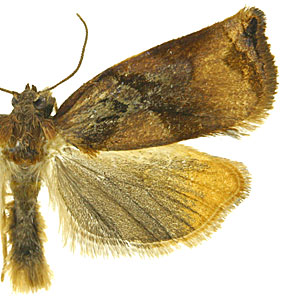Adult Recognition

FWL: 10.0-12.0 mm
Archips podana is sexually dimorphic. The male forewing is pale purplish brown with a dark-brown basal patch and well-defined median fascia. The female forewing is pale brown to purplish brown with darker reticulate markings. The hindwing in both sexes is gray basally and yellowish orange apically; the yellowish-orange coloration is usually more pronounced in the female. Dark forms of both sexes exist, where the entire forewing is overlaid with purplish-gray scaling. Males have a forewing costal fold.
Male genitalia are characterized by a well-developed uncus, reduced socii, rounded valva, and a well defined sacculus ending in a point. Female genitalia are characterized by a long ductus bursae with cestum and a single signum in the rounded corpus bursae.
Archips podana males can appear similar to males of several other Archips species, including: Archips betulana, Archips crataegana, Archips grisea, Archips magnoliana, Archips oporana, and Archips xylosteana. The yellowish-orange coloration on the apical half of the hindwing serves to separate A. podana from these other species.
Other similar species of Archips with yellowish-orange apical shading on the hindwing include Archips oporana and Archips rosana, but the amount of shading is much greater in most A. podana individuals.
Female A. podana may be confused with female Choristoneura rosaceana, which has similar markings on both the forewing and hindwing. A genitalic dissection will easily separate these two species.
Larval Morphology

Last instar larvae are approximately 15-20 mm in length. The abdomen is pale green to pale gray with pale conspicuous pinacula. The head is reddish brown. The prothoracic shield is reddish brown anteriorly and shaded with black posteriorly; a thin white line on the anterior margin of the shield separates it from the head. Thoracic legs are brown or black.
Larvae of A. podana are similar to those of Adoxophyes orana, Archips rosana, and Choristoneura rosaceana.
Biology

Archips podana completes a single generation per year over most of its range. In warmer climates a partial second generation may develop. Adults are present from the end of June through early August.
Females lay eggs in masses of 50-100 individual eggs on the surfaces of leaves. Eggs are covered by a waxy secretion that both protects and camouflages the egg mass. First instar larvae hatch in 17-23 days and begin feeding on leaves. Second and third instars feed on the surface of fruit, often creating a shelter by webbing leaves to fruit. Larvae overwinter in the third instar and continue development the following spring. Fourth instars feed on developing buds and subsequent instars feed on foliage in shelters constructed of webbed leaves. Pupation occurs in the final larval shelter.
Host plants
Archips podana is considered a major pest of apple and pear in parts of Europe. Larvae are moderately polyphagous and feed on a variety of deciduous trees and shrubs.
| Family | Genus/species | Common name |
| Betulaceae | Alnus glutinosa (L.) Gaertn. | European alder |
| Betulaceae | Corylus L. | hazelnut |
| Caprifoliaceae | Lonicera periclymenum L. | European honeysuckle |
| Celastraceae | Euonymus japonicus Thunb. | Japanese spindletree |
| Ericaceae | Vaccinium L. | blueberry |
| Fabaceae | Trifolium L. | clover |
| Fagaceae | Fagus L. | beech |
| Fagaceae | Quercus robur L. | English oak |
| Fagaceae | Quercus L. | oak |
| Grossulariaceae | Ribes L. | currant |
| Pinaceae | Picea A. Dietr. | spruce |
| Rosaceae | Cydonia oblonga Mill. | quince |
| Rosaceae | Malus domestica Borkh. | apple |
| Rosaceae | Malus sylvestris (L.) Mill. | European crab apple |
| Rosaceae | Malus Mill. | apple |
| Rosaceae | Padus avium Mill. | |
| Rosaceae | Prunus L. | cherry |
| Rosaceae | Prunus L. | plum |
| Rosaceae | Pyrus L. | pear |
| Rosaceae | Rosa rugosa Thunb. | rugosa rose |
| Rosaceae | Rubus idaeus L. | American red raspberry |
| Rosaceae | Rubus L. | blackberry |
| Rosaceae | Rubus L. | raspberry |
Distribution

Archips podana is distributed throughout Europe. Records from East Asia are of another species (Razowski 2002). It has been introduced into the Pacific Northwest where it is present in Washington and British Columbia.
References

Bradley, J. D., W. G. Tremewan and A. Smith. 1973. British Tortricoid Moths - Cochylidae and Tortricidae: Tortricinae. The Ray Society, London, England.
Crop Protection Compendium. 2007 Edition. CAB International, Wallingford, UK, 2007.
LaGasa, E. H., P. Hertzog, D. Bowden and B. Fair. 2003. Archips podana (Scopoli) (Lepidoptera: Tortricidae) host survey 2002 - Northwest Washington occurrence of an Old World tree-fruit pest new to the United States. Plant Protection Division, Washington State Department of Agriculture. WSDA PUB 080.
Razowski, J. 2002. Tortricidae of Europe, Vol. 1, Tortricinae and Chlidanotinae. Frantisek Slamka, Slovakia. 247 pp.
Photo Credits

Fig. 8: Gyorgy Csoka, Hungary Forest Research Institute, Bugwood.org
Fig. 9: Csaba Szaboky, Bugwood.org










